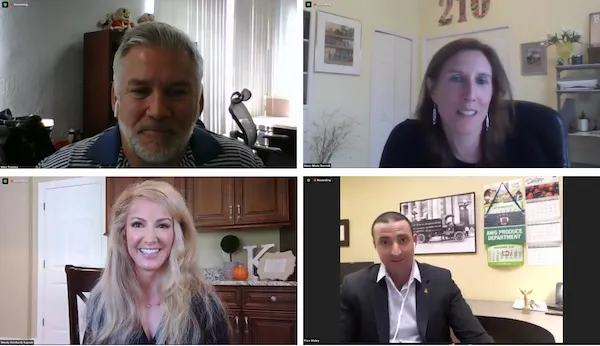This week’s PMA virtual town hall looked ahead at the end-of-the-year holiday season and how this year’s changes in consumer habits might impact this year’s holiday season. Smaller gatherings and family members joining the festivities virtually will have an effect on how consumers shop for the holidays and how retailers prepare. Anne-Marie Roerink of 210 Analytics, Price Mabry of Associated Wholesale Grocers, Mike Downey of the Military Produce Group and Wendy Reinhardt Kapsak of the Produce for Better Health Foundation weighed in on what is likely to change and how the industry can successfully adapt to it and profit from it.

Expected shopping trends
For some states, the recent Covid-19 numbers have seen an increase again, and this has led to some changes in the shopping habits of the consumers. Roerink explains: “The virus is in control of where people spend their dollars. In the last months, the comfort level in stores had increased, consumers were returning more to in-store shopping, and the e-commerce had dropped down to about 50% of what it was in the initial stages of the pandemic – which is still highly elevated compared with pre-pandemic numbers. Now, as the infection numbers are ticking back up, e-commerce is back up to its spring levels, and the in-store shopping numbers are back down.”
The holiday season will likely look very different for consumers this year. Mabry shares: “There will be much smaller dinners, as the gatherings will be smaller, but there will likely also be more dinners being cooked, so consumers will still be driven to the stores.” Roerink adds: “Not everyone will be cooking that 20-lb turkey this year, because of the smaller gathering sizes, and we’ll likely see other kinds of meats being served, like roasts for example. With that, come other side dishes, too. So, figuring out what kinds of meat might be on the table this holiday season will be a good opportunity for produce.”
Likely, the online shopping trend will continue through the holidays, so it is important that the retailers make it as easy as possible for consumers to put together their holiday meals through the online platforms. “Restaurants are aggressively going after the catering options for Thanksgiving, providing the shoppers with fully cooked meals, and I think retailers should try to do the same. Either offer it fully cooked, ready for pick-up, or by lining up everything for the shopper online, making it easy to shop for the ingredients they are looking for,” says Roerink. Reinhardt Kapsak adds: “Spending more time at home also makes it so that consumers have much more time to spend on their meals, and, especially because they’ll likely be cooking for smaller groups, they will want to try out more elaborate recipes, which is something retailers can definitely leverage.”
With consumers wanting to shop for their holiday gatherings but wanting to avoid crowds, Roerink also predicts that shoppers will likely seek out independent retailers and commissaries more this holiday season.
Leveraging the emotional connection
The health benefits of both fresh produce and floral are generally well-known for consumers, but there are still more opportunities to leverage these benefits, according to Reinhardt Kapsak. “Retailers should go beyond what the consumers already knows and tap into the emotional side of it. Health isn’t an emotion, but the concern for health is, or even the pride that a consumer feels when they are eating healthily. Put yourself into their shoes and find out what emotional need you want to solve for them. Imagery in the in-store signage should evoke not just the benefits to immune health, but also connect it back to the joy a consumer might feel for strengthening their immune systems. That concept can also be pushed into the online space with online signage that taps into these emotional needs,” she shares.
Mabry adds: “Also don’t forget the importance of a story behind the product, which can be highlighted through social media platforms to create that connection with the consumer. We’ve always had the information, but now the pandemic forced us to use it more, and I think this is something that will continue to pay off for years to come.”
Building a larger basket size
While the number of shopping trips has decreased, the overall basket size is up by 15%, according to Roerink. “This means that the shoppers are moving through the stores quickly, so we have to look at how we can optimize their purchases as they go through the stores,” she explains.
Downey shares: “It’s all about making it as easy as possible for both the consumer and the store, so things like an elaborate merchandising plan will be important. Make it easier to display the products for the stores by providing bins and other physical merchandising vehicles so the retailers can push the products that people are looking for with eye-catching displays. With a lot of people looking to get through the store quickly, we want to make that easy for them.”
In the online space, there is also a lot of opportunity for cross merchandising, Reinhardt Kapsak shares. “Consumers don’t have to drag their carts all across the stores, so retailers can be more cross-functional through the different departments, making multiple plays at once. Show the consumers what is possible, and the possibilities are endless.”
Staying at home for both parents and children has also created more opportunities for meals such as lunch and breakfast, as well as for the snacking category. “Lunch and snack time look very different now with both parents and kids at home, so there are enormous opportunities there to provide solutions for these meals,” says Roerink. “And don’t underestimate breakfast, either. People have more time to prepare and eat their breakfasts when working from home, so there are opportunities there too, especially for produce,” Reinhardt Kapsak adds.
Join next week’s virtual town hall on Wednesday, November 18th at 12:00 pm ET by registering here.
